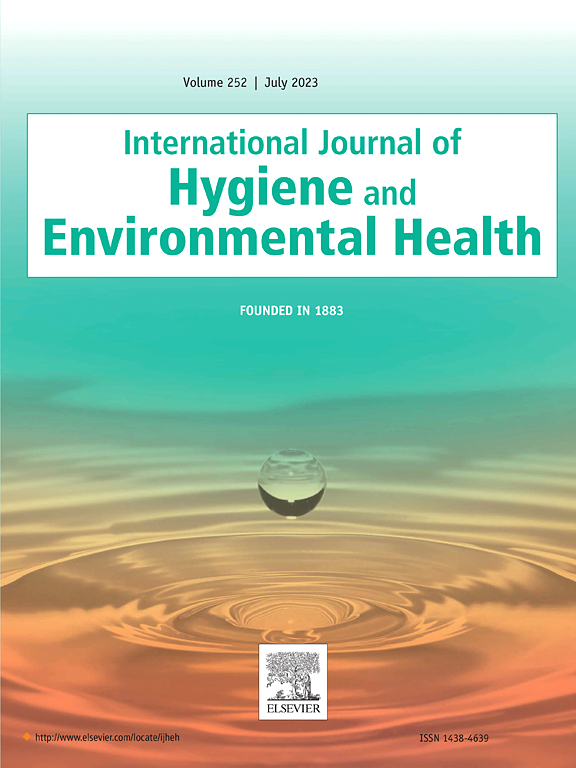Phenol biomarker concentrations in human ovarian follicular fluid and the associations with in-vitro fertilization outcomes
IF 4.4
2区 医学
Q1 INFECTIOUS DISEASES
International journal of hygiene and environmental health
Pub Date : 2025-07-01
DOI:10.1016/j.ijheh.2025.114617
引用次数: 0
Abstract
Background
Phenols are a family of short-lived endocrine disrupting chemicals found in a wide range of products and have drawn significant attention because of widespread human exposure and their potential adverse effects on reproductive health. Phenols have been widely detected in several human bodily fluids, particularly in urine and blood. However, there is limited data on phenols in human ovarian follicular fluid (FF). In addition, studies suggest associations between exposure to bisphenols and measures of infertility in humans. Nevertheless, the association of FF concentrations of bisphenols and female fertility has not been investigated.
Objectives
To quantify phenols in human ovarian FF, investigate correlations of phenol concentrations between FF and urine, evaluate trends over time, and explore any associations between FF concentrations of phenols and in-vitro fertilization (IVF) outcomes.
Methods
This analysis includes 143 women who enrolled in the Environment and Reproductive Health (EARTH) Study and underwent one IVF cycle between 2009 and 2015, with available, FF, urine and reproductive outcome data. FF concentrations of 2,4-dichloro-phenol (2,4DCP), 2,5-dichloro-phenol (2,5DCP), methyl-paraben (MPB), ethyl-paraben (EPB), propyl-paraben (PPB), butyl-paraben (BPB), bisphenol A (BPA), bisphenol S (BPS), bisphenol F (BPF), benzophenone-3 (BP3), triclosan (TCS) and triclorocarban (TCC) were quantified by isotope dilution tandem mass spectrometry. Generalized linear models were used to explore the associations between FF concentrations of bisphenols (in tertiles or dichotomized) and IVF outcomes, adjusting for confounders.
Results
Detection rates varied from high (79–95 %) for MPB, PPB and BPS, to moderate (44–65 %) for BPA, BP3 and TCS, to low (1–34 %) for 2,4DCP, 2,5DCP, EPB, BPB, BPF, TCC. Correlations between FF and urine were strong for BP3 (r = 0.86), moderate for MPB (r = 0.64) and PBP (r = 0.63), and weak for BPS (r = 0.21) and BPA (r = 0.12). FF BPA concentrations significantly decreased over time, whereas FF BPS concentrations increased. Most of the examined FF phenol biomarker concentrations were not related to early IVF outcomes (endometrial thickness, total and mature (MII) oocyte yield, fertilization rates). However, significant associations between PPB and endometrial thickness, and between BP3 and MII oocyte yield were noted, without these findings translating in any effects observed on pregnancy outcomes (implantation, clinical pregnancy and live birth).
Conclusions
We observed that most phenols were detected in FF and there were some correlations with urinary concentrations. We confirmed in FF that phenols such as BPA may be declining, while exposure to new replacements such as BPS are increasing. However, no overall associations were observed for the examined FF phenol biomarker concentrations with early IVF outcomes and pregnancy outcomes. Further research is needed to examine the potential associations of these phenols in FF, especially the newer ones that are on the rise.
人卵巢卵泡液中酚生物标志物浓度及其与体外受精结果的关系
酚类物质是一类存在于多种产品中的短寿命内分泌干扰化学物质,由于人类广泛接触酚类物质及其对生殖健康的潜在不利影响,引起了人们的极大关注。苯酚广泛存在于几种人体体液中,尤其是尿液和血液中。然而,关于人类卵巢卵泡液(FF)中酚类物质的数据有限。此外,研究表明暴露于双酚类物质与人类不孕之间存在关联。然而,双酚类FF浓度与女性生育能力的关系尚未被调查。目的量化人类卵巢FF中的酚类物质,研究FF和尿液中酚类物质浓度的相关性,评估随时间变化的趋势,并探讨FF中酚类物质浓度与体外受精(IVF)结果之间的关系。方法:本研究纳入了143名参加环境与生殖健康(EARTH)研究的妇女,她们在2009年至2015年期间接受了一个试管婴儿周期,并提供了可用的FF、尿液和生殖结果数据。采用同位素稀释串联质谱法测定FF中2,4-二氯酚(2,4 - dcp)、2,5-二氯酚(2,5 - dcp)、对羟基苯甲酸甲酯(MPB)、对羟基苯甲酸乙酯(EPB)、对羟基苯甲酸丙酯(PPB)、对羟基苯甲酸丁酯(BPB)、双酚A (BPA)、双酚S (BPS)、双酚F (BPF)、二苯甲酮-3 (BP3)、三氯生(TCS)和三氯卡班(TCC)的浓度。使用广义线性模型来探索双酚类FF浓度(四分位数或二分位数)与试管婴儿结果之间的关系,并对混杂因素进行调整。结果MPB、PPB、BPS的检出率为高检出率(79 ~ 95%),BPA、BP3、TCS的检出率为中检出率(44 ~ 65%),2,4 dcp、2,5 dcp、EPB、BPB、BPF、TCC的检出率为低检出率(1 ~ 34%)。FF与尿液的相关性为BP3强(r = 0.86), MPB和PBP中等(r = 0.64), BPS和BPA弱(r = 0.21) (r = 0.12)。随着时间的推移,FF BPA浓度显著降低,而FF BPS浓度升高。大多数检测到的FF酚生物标志物浓度与早期IVF结果(子宫内膜厚度、总卵母细胞和成熟卵母细胞数量、受精率)无关。然而,PPB与子宫内膜厚度、BP3与MII卵母细胞产量之间存在显著相关性,但这些发现并未转化为对妊娠结局(植入、临床妊娠和活产)的任何影响。结论我们观察到FF中检测到大部分酚类物质,并且与尿浓度有一定的相关性。我们在FF中证实,BPA等酚类物质可能正在减少,而BPS等新替代品的暴露量正在增加。然而,未观察到FF酚生物标志物浓度与早期IVF结局和妊娠结局之间的总体关联。需要进一步的研究来检查这些酚类物质在FF中的潜在关联,特别是那些正在上升的新发现。
本文章由计算机程序翻译,如有差异,请以英文原文为准。
求助全文
约1分钟内获得全文
求助全文
来源期刊
CiteScore
11.50
自引率
5.00%
发文量
151
审稿时长
22 days
期刊介绍:
The International Journal of Hygiene and Environmental Health serves as a multidisciplinary forum for original reports on exposure assessment and the reactions to and consequences of human exposure to the biological, chemical, and physical environment. Research reports, short communications, reviews, scientific comments, technical notes, and editorials will be peer-reviewed before acceptance for publication. Priority will be given to articles on epidemiological aspects of environmental toxicology, health risk assessments, susceptible (sub) populations, sanitation and clean water, human biomonitoring, environmental medicine, and public health aspects of exposure-related outcomes.

 求助内容:
求助内容: 应助结果提醒方式:
应助结果提醒方式:


